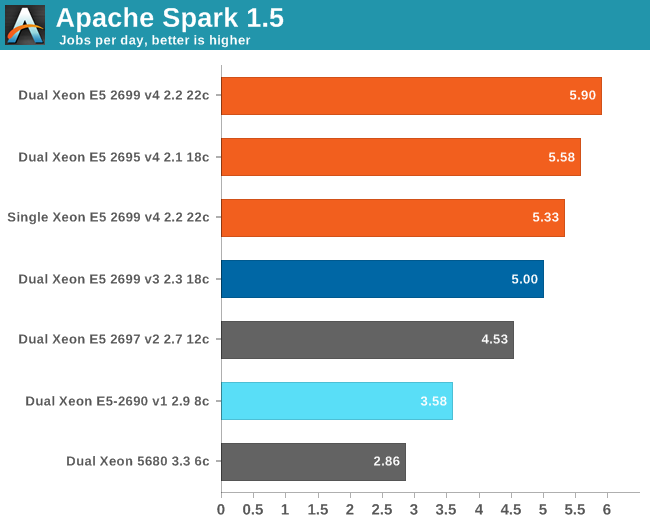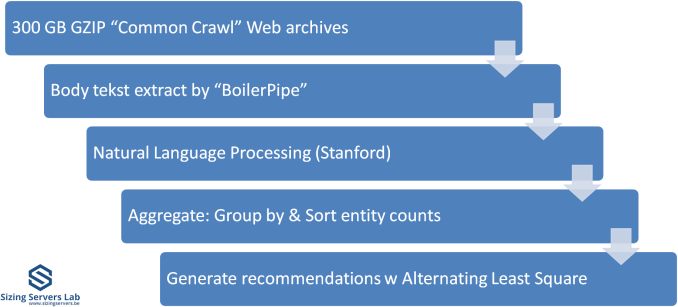The Intel Xeon E5 v4 Review: Testing Broadwell-EP With Demanding Server Workloads
by Johan De Gelas on March 31, 2016 12:30 PM EST- Posted in
- CPUs
- Intel
- Xeon
- Enterprise
- Enterprise CPUs
- Broadwell
Spark Benchmarking
Spark is wonderful framework, but you need some decent input data and some good coding skills to really test it. Speeding up Big Data applications is the top priority project at the lab I work for (Sizing Servers Lab of the University College of West-Flanders), so I was able to turn to the coding skills of Wannes De Smet to produce a benchmark that uses many of the Spark features and is based upon real world usage.
The test is described in the graph above. We first start with 300 GB of compressed data gathered from the CommonCrawl. These compressed files are a large amount of web archives. We decompress the data on the fly to avoid a long wait that is mostly storage related. We then extract the meaningful text data out of the archives by using the Java library "BoilerPipe". Using the Stanford CoreNLP Natural Language Processing Toolkit, we extract entities ("words that mean something") out of the text, and then count which URLs have the highest occurrence of these entities. The Alternating Least Square algorithm is then used to recommend which URLs are the most interesting for a certain subject.
We tested with Apache Spark 1.5 in standalone mode (non-clustered) as it took us a long time to make sure that the results were repetitive.
Here are the results:

Spark threw us back into nineties, to the time that several workloads still took ages on high-end computers. It takes no less than six and half hours on a 16-core Xeon E5-2690 running at 2.9 GHz to crunch through 300 GB of web data and extract anything meaningful out of it. So we have to express our times in "jobs per day" instead of the usual "jobs per hour". Another data point: a Xeon D-1540 (8 Broadwell cores at 2.6 GHz) needs no less than 11 hours to do the same thing. Using DDR4 at 2400 MHz instead of 1600 MHz gives a boost of around 5 to 8%.
About 10% of the time is spent on splitting up the workload in slices, 30% of the time is spent in language processing, and 50% of the time is spent on aggregating and counting. Only 3% is spent waiting on disk I/O, which is pretty amazing as we handle 300 GB of data and perform up to 55 GB of (Shuffle) writes. The ALS phase scales badly, but takes only 3 to 5% of the time. But there is no escaping on Amdahl's law: throwing more cores gives diminishing returns. Meanwhile the use of remote memory seriously slows processing down: the dual Xeon increases performance only by 11% compared to the single CPU. Broadwell does well here: a Broadwell core at 2.2 GHz is 12% faster than a Haswell at 2.3 GHz.
We are still just starting to understand what really makes Spark fly and version 1.6 might still change quite a bit. But it is clear that this is one of the workloads that will make top SKUs popular: a real killer app for the most potent CPUs. You can replace a dual Xeon 5680 with one Xeon E5-2699 v4 and almost double your performance while halving the CPU power consumption.











112 Comments
View All Comments
jhh - Thursday, March 31, 2016 - link
The article says TSX-NI is supported on the E5, but if one looks at Intel ARK, it say it's not. Do the processors say they support TSX-NI? Or is this another one of the things which will be left for the E7?JohanAnandtech - Friday, April 1, 2016 - link
Intel's official slides say: "supports TSX". All SKUs, no exceptions.Oxford Guy - Thursday, March 31, 2016 - link
Bigger, badder, still obsolete cores.patrickjp93 - Friday, April 1, 2016 - link
Obsolete? Troll.Oxford Guy - Tuesday, April 5, 2016 - link
Unlike you, propagandist, I know what Skylake is.benzosaurus - Thursday, March 31, 2016 - link
"You can replace a dual Xeon 5680 with one Xeon E5-2699 v4 and almost double your performance while halving the CPU power consumption."I mean you can, but you can buy 4 X5680s for a quarter the price of a single E5-2699v4. It takes a lot of power savings to make that worthwhile. The pricing in the server market's always seemed weirdly non-linear to me.
warreo - Friday, April 1, 2016 - link
Presumably, it's not just about TCO. Space is at a premium in a datacenter, and so being able to fit more performance per sq ft also warrants a higher price, just like how notebook parts have historically been more expensive than their desktop equivalents.ShieTar - Friday, April 1, 2016 - link
But you don't get 4 1366-Systems for the price of one 2011-3 System. Depending on your Memory, Storage and Interconnect Needs, even two full Systems based on the Xeon 5680 may cost you more than one system based on the E5-2699 v4. One less Infiniband-Adapter can easily save you 500$ in Hardware.And you are not only halving the CPU power consumption, but also the power consumption of the rest of the system that you no longer use, so instead of 140W you are saving probably at least 200W per System, which can already add up to more than 1k$ in electricity and cooling bills for a 24/7 machine running for 3 years.
And last, but by no means least, less parts means less space, less chance for failure, less maintenance effort. If you happily waste a few hours here or there to maintain your own workstation, you don't do the math, but if you have to pay somebody to do it, salaries matter quickly. With an MTBF for an entire server rarely being much higher than 40.000, and recovery/repair easily taking you a person-day of work, each system generates about 1.7 hours of work per year. Cost of work (it's more than salaries, of course) probably comes up to 100$ for a skilled technical administrator, thus producing another 500$ over 3 years of added operational cost.
And of course, space matters as well. If your data center is filled, it can be more cost effective to replace the old CPUs with new expensive ones, rather than build a new facility to fill with more old Systems.
If you add it all up, I doubt you can get a System with an Xeon 5680 and operate it over 3 years for anything below 20.000$. So going from two 20.000$-Systems to a single 24.000$ Dollar System (because of an extra 4000$ for the big CPU) should save you a lot of money in the long run.
JohanAnandtech - Friday, April 1, 2016 - link
Where do you get your pricing info from? I can not imagine that server vendors still sell X5680s.extide - Friday, April 1, 2016 - link
Yeah, if you go used. No enterprise sysadmin worth his salt is ever going to put used gear that is not in warranty, and in support into production.